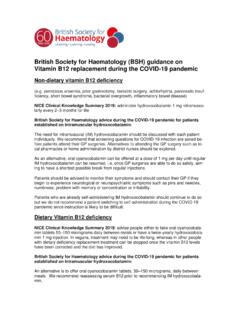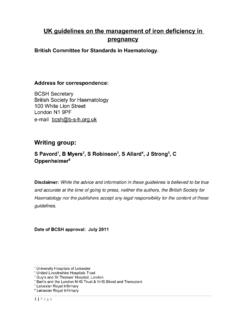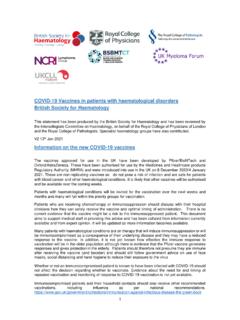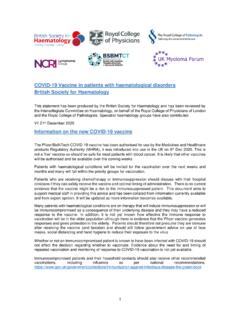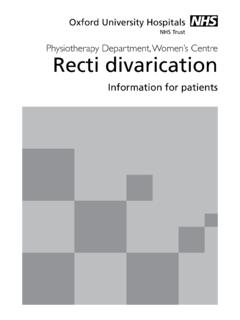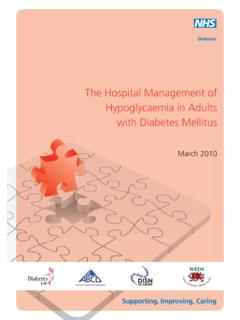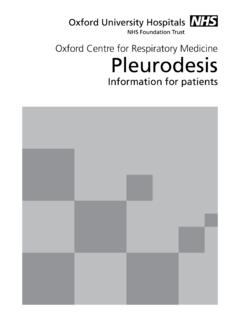Transcription of Guidelines for the Use of Platelet Transfusions A …
1 1 Guidelines for the Use of Platelet Transfusions A British Society for Haematology Guideline Lise J Estcourt1, Janet Birchall (Writing Group Chair)2, Shubha Allard (BCSH Task Force Member)3, Stephen J Bassey4, Peter Hersey5, J Paul Kerr6, Andrew D Mumford7, Simon J Stanworth8, Hazel Tinegate9 on behalf of the British Committee for Standards in Haematology. 1 NHSBT and Radcliffe Department of Medicine, University of Oxford, Oxford, 2 NHSBT and Department of Haematology, North Bristol NHS Trust, Bristol, 3 NHSBT and Department of Haematology, Royal London Hospital, London, 4 Department of Haematology, Royal Cornwall Hospital Trust, 5 Department of Critical Care Medicine & Anaesthesia, City Hospitals Sunderland NHS Foundation Trust, 6 Department of Haematology, Royal Devon & Exeter NHS Foundation Trust, Exeter, 7 School of Cellular and Molecular Medicine, University of Bristol, Bristol, 8 NHSBT and Department of Haematology, John Radcliffe Hospital Oxford, 9 NHSBT Newcastle upon Tyne.
2 Correspondence: BSH Administrator, British Society for Haematology, 100 White Lion Street, London N1 9PF, UK. E-mail: Introduction The demand for platelets in England was stable at around 220,000 adult therapeutic doses (ATD) per year until 2007/8 at which point demand has increased year on year to 275,000 ATD in 2014/15, an increase of 25%. Similar rises in demand have been seen in Australia and the United States. A recent review which considered causes for this dramatic rise identified that an ageing population and an increase in the incidence of haematological malignancies (with increased treatment intensity, duration and survival) accounted for most of this change (Estcourt 2014). In 2012 the population aged over 70 in the UK was million.
3 By 2046 this number is expected to reach 15 million (Office of National Statistics (ONS) 2013). In addition, since 1990, the number of haematopoietic stem cell transplants performed in Europe has risen from 4,200 to over 30,000 annually (Passweg, et al 2012). 2 Although a national audit of Platelet use in haematology identified that 28% of Transfusions were outside of Guidelines (Estcourt, et al 2012b) these findings demonstrate less inappropriate use than a previous audit (Qureshi, et al 2007). An increase in the proportion of inappropriate use is therefore unlikely to have contributed significantly to recent changes in demand (Estcourt 2014). Currently up to 67% of all platelets are used in the management of patients with haematological malignancies (Cameron, et al 2007, Charlton, et al 2014, Greeno, et al 2007, Jones, et al 2013, Pendry and Davies 2011).
4 Much of the remainder are used in cardiac surgery (7-10%) and in intensive care (5-9%). In contrast to Platelet demand, the donor base is steadily dropping with a 35% reduction in active donors from million in 2000 to million in 2015 (NHS Blood & Transplant data). As the majority of platelets in the UK are collected from approximately 14,000 registered Platelet donors (apheresis platelets), and whole blood donors give blood on average times a year this could have a significant impact on the future supply (European Blood Alliance 2015, European Committee (Partial Agreement) on Blood Transfusion CD-P-TS 2016). SCOPE This guideline aims to provide practical advice on Platelet Transfusions to help clinicians to decide when support is expected to be beneficial and to reduce inappropriate use.
5 If the reason for thrombocytopenia is unclear, further investigation is required as this is likely to influence management. This document will cover practice in adults relevant to the UK and replace the 2003 BCSH Platelet use guideline. A one page summary document is available in appendix 1. The indications for Platelet transfusion in children and neonates and more general specifications such as cytomegalovirus (CMV) status and irradiation are not included, and can be found elsewhere (New, et al 2016, SaBTO 2012, Treleaven, et al 2011). 3 Methodology The classification of Platelet transfusion into either therapeutic to treat bleeding or prophylactic to prevent bleeding was based on the modified WHO bleeding score (Table I) (Stanworth, et al 2013a).
6 Recommendations for prophylactic transfusion relate to patients with bleeding scores of 0 or 1 and therapeutic transfusion to patients with bleeding scores of 2 or higher. For each indication, the recommendations include a threshold or target Platelet count and a suggested dose, when relevant. The Grading of Recommendations, Assessment, Development and Evaluation (GRADE) nomenclature was used to evaluate levels of evidence and to assess the strength of recommendations. The GRADE criteria are specified on the BCSH website ( ) and the GRADE working group website ( ). Literature review details A search of published literature was undertaken using the evidence from several systematic reviews that are either currently being undertaken by members of the writing group (Estcourt, et al 2014a, Estcourt, et al 2014b, Estcourt, et al 2014c), or that have been recently published (Crighton, et al 2015, Hedges, et al 2007, Kumar, et al 2014, Lieberman, et al 2013, Nahirniak, et al 2015, Pavenski, et al 2013, van Veen, et al 2010, Vassallo, et al 2014, Wardrop, et al 2013).
7 This was supplemented by searching PubMed and the UKBTS/SRI Transfusion Evidence Library ( ) up to November 2014 using specific search terms relevant to each section of the Guidelines . 4 Working Group Membership The guideline group was selected to be representative of UK based medical (anaesthetics, benign and malignant haematology, haemostasis, transfusion) and laboratory experts with practical experience in Platelet transfusion. Review Given the breadth of application, the draft guideline was provided to sounding board members of the Haemato-oncology, General Haematology, Haemostasis and Thrombosis, and Transfusion Task Forces of BCSH for comment and subsequent revision. SUMMARY OF KEY RECOMMENDATIONS If the reason for thrombocytopenia is unclear, further investigation is required to determine appropriate management (1A) Recommendations for Prophylactic Transfusion of Platelets to Patients with Thrombocytopenia Because Of Reversible Bone Marrow Failure Where Recovery Is Anticipated Give prophylactic Platelet Transfusions ( Platelet Transfusions to patients who do not have clinically significant bleeding [WHO grade 0 or 1] and do not require a procedure) to patients with reversible bone marrow failure receiving intensive chemotherapy or undergoing allogeneic HSCT to maintain a Platelet count at or above 10 x 109/L (1B) Use only one adult dose (one unit)
8 Routinely for prophylactic Platelet Transfusions (1A) Consider not giving prophylactic Platelet Transfusions to well patients with no evidence of bleeding who have had an autologous stem cell transplant (2B) Consider increasing the threshold for prophylactic Platelet transfusion to between 10 and 20 x109/L in patients judged to have additional risk factors for bleeding. Individual review is required. (2C) 5 Recommendations for Prophylactic Transfusion of Platelets to Patients with Thrombocytopenia Because Of Chronic Bone Marrow Failure, Where Recovery Is Not Anticipated Use a no prophylactic Platelet transfusion strategy for asymptomatic patients with chronic bone marrow failure (including those taking low dose oral chemotherapy or azacitidine) (2B) Give prophylactic Platelet Transfusions to patients with chronic bone marrow failure receiving intensive treatment (1B) Manage patients with chronic bleeding of WHO grade 2 or above individually, according to the severity of their symptoms and signs.
9 Consider a strategy of prophylaxis ( twice a week) (2C) Recommendations for Prophylactic Transfusion of Platelets to Other Patient Groups Use the Platelet count thresholds for reversible bone marrow failure as a general guide for prophylactic Platelet transfusion in patients with critical illness in the absence of bleeding or planned procedures. (2C) Recommendations for Prophylactic Platelet Transfusion Prior To Procedures or Surgery Whenever possible use a procedure/equipment associated with the lowest bleeding risk. Apply local measures, such as compression, to reduce the risk of bleeding post-procedure. (1C) Do not give Platelet Transfusions routinely prior to: o bone marrow aspirate or trephine biopsy (1B) o peripherally inserted central catheters (PICCs) (2C) o traction removal of tunnelled CVCs (2C) o cataract surgery (2C) Consider performing the following procedures above the Platelet count threshold indicated 6 o venous central lines (both tunnelled and un-tunnelled), inserted by experienced staff using ultrasound guidance techniques, when the Platelet count is > 20x109/L.
10 (1B) o lumbar puncture when the Platelet count is 40x109/L. (2C) o insertion/removal of epidural catheter when the Platelet count is 80x109/L. (2C) o major surgery - when the Platelet count is > 50x109/L (1C) o neurosurgery or ophthalmic surgery involving the posterior segment of the eye when the Platelet count is > 100x109/L (1C) o percutaneous liver biopsy when the Platelet count is > 50 x 109/L (2B). Consider trans-jugular biopsy if the Platelet count is below this level (2B) Prior to renal biopsy ensure potential risk factors for bleeding are corrected: anaemia (iron and erythropoietin), uraemia (dialysis) (1B). If renal biopsy is urgent consider desmopressin (DDAVP) pre-procedure (1B) or oestrogen if time allows (2B) Avoid Platelet transfusion in renal failure since infused platelets will acquire a dysfunction similar to the patients own platelets and Platelet transfusion may result in alloimmunisation (1B) Recommendations for Therapeutic Platelet Transfusions In severe bleeding, maintain the Platelet count above 50 x 109/l.
